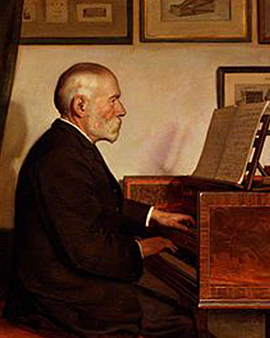


In the ornate melodies and musical textures of 19th century England, one name resonated with particular clarity and resonance: Alfred James Hipkins. Born on June 17, 1826, Hipkins made his mark on the musical world as a musician, musicologist, and musical antiquarian whose influence can still be felt in every finely tuned art print. At just 14 years old, Hipkins entered the workshop of John Broadwood & Sons' renowned piano factory to begin his apprenticeship as a piano tuner. His passion and talent for music led him to be entrusted with the task of training all of Broadwood's tuners in equal temperament in 1846, a departure from the Meanone system that had prevailed until then. Despite only limited musical training, Hipkins gained an excellent reputation as an interpreter of Chopin's music and rose to the position of "senior worker," a position he held for the rest of his life at Broadwood & Sons. He also served as a critic for The Athenæum and The Musical Times, and lectured on musical instruments and their capabilities to the Royal Society of Arts in 1891.
Hipkins' profound knowledge and tireless curiosity led him on a lifelong journey to explore the mysteries of music and keyboard instruments. In this field he became an unrivaled authority, and his writings and research, including 134 articles for the Grove's Dictionary and several for the Encyclopædia Britannica, remain authoritative sources to this day. His discovery of Gottfried Silbermann's pianos that had belonged to Frederick the Great and confirmation of their construction based on Bartolomeo Cristofori's design attest to his acumen and dedication to music. Hipkins' life was shaped not only by his professional passion, but also by his family. His son John became a noted wood engraver, and his daughter Edith gained recognition as a successful portrait painter whose works are recorded and uniquely honor her father. Alfred James Hipkins left the world an invaluable musical legacy. His collection of tuning forks went to the Royal Institution, and his unique collection of musical instruments now enriches the Royal College of Music. His interpretations of Bach's "Goldberg" Variations and the Chromatic Fantasy and Fugue had a profound influence on other musicians such as Arnold Dolmetsch. Alfred James Hipkins' life and work are a compelling example of how a life of passion and dedication can change the sound of the world. Each art print that captures his musical legacy is an expression of that indelible melody.

In the ornate melodies and musical textures of 19th century England, one name resonated with particular clarity and resonance: Alfred James Hipkins. Born on June 17, 1826, Hipkins made his mark on the musical world as a musician, musicologist, and musical antiquarian whose influence can still be felt in every finely tuned art print. At just 14 years old, Hipkins entered the workshop of John Broadwood & Sons' renowned piano factory to begin his apprenticeship as a piano tuner. His passion and talent for music led him to be entrusted with the task of training all of Broadwood's tuners in equal temperament in 1846, a departure from the Meanone system that had prevailed until then. Despite only limited musical training, Hipkins gained an excellent reputation as an interpreter of Chopin's music and rose to the position of "senior worker," a position he held for the rest of his life at Broadwood & Sons. He also served as a critic for The Athenæum and The Musical Times, and lectured on musical instruments and their capabilities to the Royal Society of Arts in 1891.
Hipkins' profound knowledge and tireless curiosity led him on a lifelong journey to explore the mysteries of music and keyboard instruments. In this field he became an unrivaled authority, and his writings and research, including 134 articles for the Grove's Dictionary and several for the Encyclopædia Britannica, remain authoritative sources to this day. His discovery of Gottfried Silbermann's pianos that had belonged to Frederick the Great and confirmation of their construction based on Bartolomeo Cristofori's design attest to his acumen and dedication to music. Hipkins' life was shaped not only by his professional passion, but also by his family. His son John became a noted wood engraver, and his daughter Edith gained recognition as a successful portrait painter whose works are recorded and uniquely honor her father. Alfred James Hipkins left the world an invaluable musical legacy. His collection of tuning forks went to the Royal Institution, and his unique collection of musical instruments now enriches the Royal College of Music. His interpretations of Bach's "Goldberg" Variations and the Chromatic Fantasy and Fugue had a profound influence on other musicians such as Arnold Dolmetsch. Alfred James Hipkins' life and work are a compelling example of how a life of passion and dedication can change the sound of the world. Each art print that captures his musical legacy is an expression of that indelible melody.
Page 1 / 1








